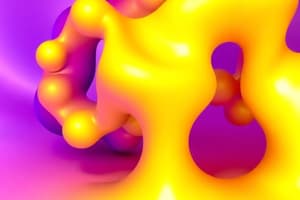Podcast
Questions and Answers
What is the purpose of discretization methods in numeric data?
What is the purpose of discretization methods in numeric data?
- To transform continuous data into categorical data (correct)
- To reduce data dimensionality
- To improve data visualization
- To remove outliers from the data
What is the main characteristic of a Data Warehouse?
What is the main characteristic of a Data Warehouse?
- It is a database management system
- It is a collection of data from various sources (correct)
- It is a software tool for data visualization
- It is a methodology for data analysis
What is the primary goal of data summarization?
What is the primary goal of data summarization?
- To improve data accuracy
- To reduce data complexity
- To provide a concise representation of data (correct)
- To identify data outliers
Which approach to clustering is based on the idea of dividing the data into a set of non-overlapping clusters?
Which approach to clustering is based on the idea of dividing the data into a set of non-overlapping clusters?
What is the key difference between the K-means Algorithm and the Hierarchical Approach?
What is the key difference between the K-means Algorithm and the Hierarchical Approach?
What is the primary advantage of using the Hierarchical Approach over the K-means Algorithm?
What is the primary advantage of using the Hierarchical Approach over the K-means Algorithm?
What is the purpose of partitioning in data clustering?
What is the purpose of partitioning in data clustering?
What is the primary goal of data warehousing?
What is the primary goal of data warehousing?
What is the key benefit of using data summarization in data analysis?
What is the key benefit of using data summarization in data analysis?
What is the primary characteristic of a Data Warehouse?
What is the primary characteristic of a Data Warehouse?
Flashcards are hidden until you start studying
Study Notes
Data Reduction Strategies
- Dimensionality reduction removes unimportant attributes, and methods include wavelet transforms, PCA, and feature subset selection.
- Numerosity reduction (Data Reduction) techniques include regression and log-linear models, histograms, clustering, sampling, and data cube aggregation.
- Data compression is another strategy.
Principal Component Analysis (PCA)
- Finds a projection that captures the largest amount of variation in data.
- Projects original data onto a smaller space, resulting in dimensionality reduction.
Example of PCA
- Calculate the dot product of two vectors (d1 and d2) to find the cosine of the angle between them.
- Calculate the magnitude of each vector using the formula ||d|| = (sum of squares of each element)^(1/2).
Correlation
- Measures the linear relationship between objects.
- Computes correlation by standardizing data objects (p and q) and taking their dot product.
- Formula: correlation(p, q) = p' ∙ q'.
Data Exploration & Visualization
Summary Statistics
- Numbers that summarize properties of the data, including frequency, location, and spread.
- Examples: location - mean, spread - standard deviation.
- Most summary statistics can be calculated in a single pass through the data.
Frequency and Mode
- Frequency of an attribute value is the percentage of time the value occurs in the data set.
- For numeric data, use discretization methods.
Data Warehousing and On-line Analytical
What is a Data Warehouse?
- Defined in many different ways, but not rigorously.
Studying That Suits You
Use AI to generate personalized quizzes and flashcards to suit your learning preferences.




